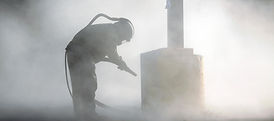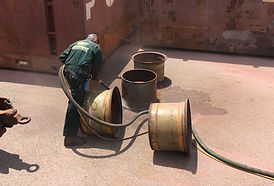
What is Slurry Blasting?
LEARN MORE
Slurry blasting is a form of wet abrasive technology that incorporates three different elements--H20, compressed air, and an aggregate of choice--all working together.
Greener Blast's method of cleaning follows NACE/SSPC, Joint Surface Preparation Wet Abrasive Blasting (WAB) standard:
“Use of an abrasive slurry under pressure to achieve the specified WAB degree of cleanliness.” Item 1.1 Element 3.
Process

Hydraulically pressurize vessel with pneumatic water pump.
Air stream carries aggregate down the blast hose and out of the nozzle propelling it to a desired surface.
Mix abrasive and water in pressure vessel.
Aggregate travels through system under hydraulic pressure and into compressed air stream.
Minimal abrasive coupled with water result in maximum efficiency. As a result, each particle travels at a much higher rate of speed in the blast hose, optimizing cleaning rates.

Source: www.sspc.org
Clean and Efficient
Less Abrasive and Water Creates Nearly Dust-Free Environment
The Greener Blast's cleaning process uses a fraction of the abrasive and water, creating a nearly dust-free work environment. The reduction in the amount of abrasive used (100-200 lbs. per hour) means that the environmental impact is far less than traditional methods of dry blasting.
Garnet, A Clean Product
Greener Blast units are not limited to a specific material. However, garnet--a clean product--is the most efficient abrasive in the equipment. Therefore, a clean product is being used and disposed of and at a fraction of the volume.
Example:
Greener Blast machines consumes 150-200 lbs. of abrasive per hour with a #8 nozzle while removing 20 mils of coatings with garnet (+/-).
The Greener Blast machine will consume 1-2 lbs. of abrasive per square foot with a #8 nozzle using garnet.
Required Containment Minimized
The Greener Blast WAB machine minimizes required containment by:
-
Consuming 80% less abrasive (compared to traditional dry methods).
-
Combining water and abrasive.
-
Surface coatings and contaminants emulsify with the water and grit. Nearly eliminating airborne dust. Utilizing a hard abrasive, such as garnet, eliminates fracturing on contact with the surface being prepared.
-
Garnet, a dust free product in bag, will reduce airborne dust.

